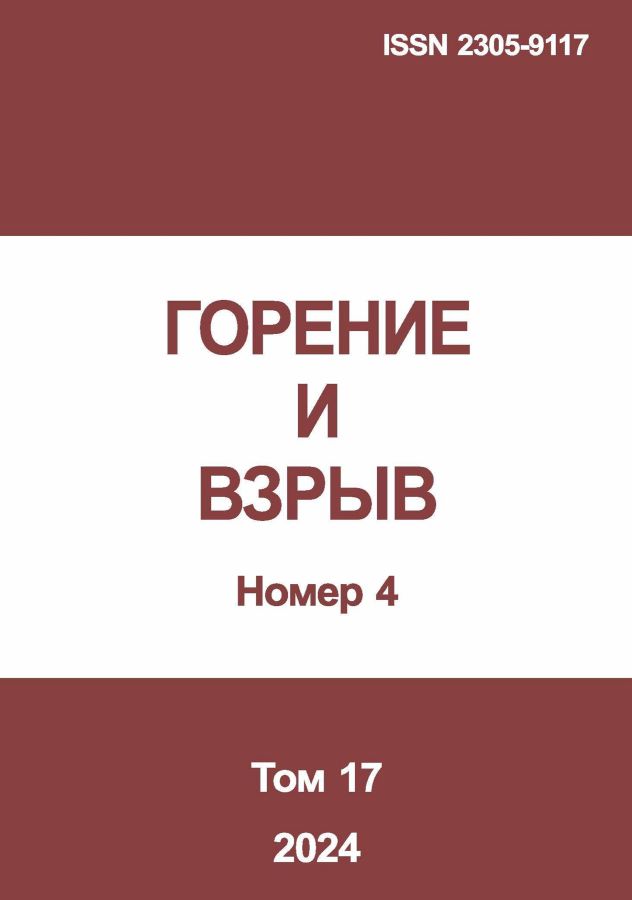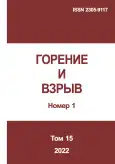Том 15, № 1 (2022)
Моделирование образования наночастиц углерода при быстром охлаждении углеродного газа
Аннотация
На основе квазиравновесного термодинамического и молекулярно-динамического (МД) моделирования рассчитан процесс образования наночастиц углерода при быстром охлаждении углеродного газа, нагретого до высокой температуры при постоянной плотности, за счет конденсации из газовой фазы в конденсированную наноуглеродную фазу. Для этого в термодинамическом расчете учтена повышенная энтальпия образования для наночастиц углерода. По результатам МД расчета рекомендованы три параметризации реакционно-силовых полей (ReaxFF-CHO, ReaxFF-c2013 и ReaxFF-PAH) для МД моделирования образования наноуглеродных частиц.
 3-10
3-10


Влияние добавок метана, бензола и радикалов СН3, СН2 и СН на процесс образования частиц сажи при пиролизе сильно разбавленных смесей ацетилена с аргоном
Аннотация
Рассмотрено влияние добавок метана, бензола и радикалов СН3, СН2 и СН на процесс образования частиц сажи при пиролизе сильно разбавленных смесей ацетилена с аргоном. Проведено прямое сравнение результатов детальных кинетических расчетов образования частиц сажи при пиролизе смесей ацетилена, бензола и метана с аргоном по единой кинетической модели сажеобразования с результатами собственных экспериментов авторов на ударной трубе в отраженных ударных волнах. Полученное хорошее согласие результатов кинетических расчетов с результатами экспериментов явилось основанием для проведения численных экспериментов для очень сильно разбавленных смесей и повышенных давлений, что позволило сохранить концентрацию атомов углерода в исследуемой смеси и свести к минимуму изменение температуры в процессе пиролиза исследуемой смеси и образования конденсированной дисперсной фазы.
 11-21
11-21


Сажеобразование при пиролизе этилена с добавками метанола и бутанола
Аннотация
Экспериментально исследован процесс сажеобразования при пиролизе этилена с добавками спиртов: метанола и бутанола за ударными волнами в диапазоне температур 2009–2524 K и давлений 2,56–3,58 бар. Методом лазерной экстинкции на длине волны 633 нм измерены временные профили оптической плотности среды, отражающие выход сажи. Размеры образующихся углеродных наночастиц измерены методом лазерно-индуцированной инкандесценции (ЛИИ). На основании проведенных измерений определены температурные зависимости выхода сажи, размеров частиц и времен индукции появления конденсированной фазы. Показано, что добавки метанола и бутанола ускоряют и увеличивают выход сажи. Наблюдаемый эффект промотирования сажеобразования проявляется сильнее при добавке бутанола, чем метанола. Обсуждаются кинетические причины влияния метанола и бутанола на пиролиз этилена.
 22-29
22-29


Экспериментальное исследование окислительного крекинга этан-этиленовых смесей при давлениях 1–3 атм
Аннотация
Актуальной задачей газохимии является переработка нефтезаводских газов (НЗГ), представляющих собой непостоянные композиции, состав которых может существенно варьироваться на различных нефтеперерабатывающих предприятиях. Работа посвящена развитию научных основ нового способа переработки НЗГ, первой стадией которого является окислительный крекинг углеводородов , входящих в состав НЗГ, в ценные продукты с высокой добавленной стоимостью. В проточном кварцевом реакторе проведены экспериментальные исследования окислительного крекинга этана и его смесей этиленом. Эксперименты проводились при давлениях 1–3 атм, температурах от 500 до 750 °C, времени реакции 2 с, начальном соотношении С/О в диапазоне 2,3–2,5 (α = 0,115–0,124) в смесях, разбавленных азотом. Показаны различия в реакционной способности этана и этилена на окислительных стадиях процесса для этих условий.
 30-36
30-36


Влияние природы пленкообразующих агентов на термозащитные свойства вспениваемых композиций
Аннотация
Огнезащита строительных конструкций и их элементов из полимерных композиционных материалов осуществляется с применением противопожарных муфт, снабженных вкладышами из вспениваемых материалов. При возникновении пожара обеспечивается перекрытие распространения пламени по полимерным коммуникациям за счет образования огнетермоизолирующей вспененной преграды, не допускаюшей разогрева полимерного легкоплавкого материала до 120 °C. Для выяснения причин, обусловливающих огнетермозащитную эффективность противопожарных преград, проведены сопоставительные исследования термических и физико-механических свойств двух вспениваемых композиций и продуктов их термообработки. Композиции при одной и той же газококсообразующей системе (ГКС) (полифосфат аммония (ПФА) / пентаэритрит (ПЭТ) / доломит (Дл) / терморасширяющийся графит (ТРГ)) отличались природой связующего и термозащитной эффективностью. С использованием комплексного термического, рентгенографического анализов, сканирующей электронной микроскопии (СЭМ), ряда стандартных и оригинальных методик установлено, что лучшие физико-механические, термоизолирующие и морфологические свойства исследуемых термовспениваемых композиций (ТВК) и их коксовых остатков достигаются при сближении температурных интервалов формирования органоминерального каркаса и образования летучих продуктов термоокисления. Полученная информация о влиянии совмещения температурных интервалов образования газообразных продуктов полимерными связующими и органоминерального каркаса исследуемыми ГКС на качественные и количественные характеристики ТВК позволяет направленно подходить к увеличению эффективности известных вспениваемых составов и выбору ингредиентов для создания новых термозащитных материалов с улучшенными свойствами.
 37-46
37-46


Моделирование ячеистой структуры детонационной волны в стехиометрической смеси синтез-газа с окислителем
Аннотация
Предложена обобщенная двустадийная модель химической кинетики детонационного горения двухтопливной стехиометрической смеси синтез-газа с окислителем. Модель позволяет рассчитывать тепловой эффект химической реакции, молярную массу и внутреннюю энергию смеси без расчета ее детального химического состава. Разработан алгоритм расчета периода индукции химической реакции в рассматриваемой двухтопливной смеси, основанный на формулах для расчета периода индукции в однотопливных смесях каждого из горючих компонентов. Сделан двумерный численный расчет ячеистой многофронтовой структуры детонационной волны (ДВ) в стехиометрической смеси синтез-газа с воздухом при различном соотношении между горючими. Химические превращения описывались предложенной кинетической моделью. Полученный размер детонационной ячейки, а также качественная структура ДВ (в том числе ее перестройка от регулярной к нерегулярной при увеличении концентрации оксида углерода) хорошо соответствуют эксперименту.
 47-56
47-56


Разработка и тестирование прибора для видеорегистрации детонационных волн
Аннотация
Описаны методика разработки и результаты тестирования прибора для оптической регистрации процессов непрерывной спиновой детонации (НСД). Рассмотрены способы улучшения качества получаемых изображений, зарегистрированных в процессе проведения экспериментов, а также методы сокращения как вычислительных ресурсов, так и времени обработки данных. Приведены программные и аппаратные способы выделения нужных фрагментов изображений и их обработка. Разработанный прибор был испытан и показал свою эффективность при видеосъемке детонационных волн при условии использования подсветки процессов ацетиленом или другим углеродосодержащим газом. При этом важной особенностью прибора является способность производить видеосъемку одной строкой длиной 1092 пикселей при максимальной кадровой частоте.
 57-66
57-66


Форсажная камера с детонационным горением керосина
Аннотация
Представлены результаты новой серии огневых стендовых испытаний детонационной форсажной камеры сгорания (ДФКС) в составе турбореактивного двигателя (ТРД). В отличие от предыдущих испытаний с последовательным расположением ТРД и ДФКС в новой серии предусмотрено газодинамическое разделение воздушных потоков: воздух в ДФКС подавался раздельно с помощью вспомогательной силовой установки. Разделение воздушных потоков позволило обеспечить устойчивую работу комбинированной силовой установки при включении ДФКС на разных режимах работы ТРД. В испытаниях зарегистрирован устойчивый режим непрерывно-детонационного спинового горения авиационного керосина с одной детонационной волной, причем детонационное горение керосина в ДФКС не влияло на работу ТРД.
 67-71
67-71


Зажигание газовой смеси продуктами горения термитного состава Al/CuO
Аннотация
Приведены новые экспериментальные результаты по динамике облака продуктов взрывного горения механоактивированного состава Al/CuO. С помощью методов скоростной фоторегистрации, пирометрических измерений, фотоэлектрических и электроконтактных датчиков определены параметры облака продуктов горения в зависимости от массы смеси. Рассмотрены различные способы зажигания и формирования потока продуктов. Определены оптимальные условия формирования факела для зажигания горючих газовоздушных смесей.
 72-81
72-81


Особенности горения нанотермитов на основе наноалюминия при лазерном инициировании
Аннотация
Приведены результаты исследования процесса лазерного инициирования термитных смесей наноразмерных порошков Al с оксидами меди, висмута, молибдена и никеля. Получены новые данные о минимальной энергии инициирования и скорости горения в зависимости от плотности и соотношения компонентов. Инициирование осуществлялось импульсом лазерного диода с длиной волны 808 нм, плотность мощности излучения до 700 Вт/см2. Параметры процесса регистрировались с помощью многоканального пирометра и высокоскоростной видеокамеры. Проведено измерение яркостной температуры продуктов горения нанотермитов (НТ). Изучено влияние инертных светопоглощающих наноразмерных добавок на пороговые параметры лазерного импульса и скорость горения. На основании полученных результатов выдвинуты предположения о механизме инициирования и протекании реакции при воздействии лазерного излучения.
 82-97
82-97


Усовершенствованная модель оптического капсюля-детонатора
Аннотация
Создана усовершенствованная модель оптического капсюля-детонатора (ОКД) на основе штатного капсюля-детонатора № 8 с улучшенной оптоволоконной системой ввода излучения, инициируемая непрерывным инфракрасным (ИК) лазером с длиной волны λ = 975 нм. Исследованы фоточувствительные составы на основе инициирующих взрывчатых веществ (ИВВ) — азида свинца (АС), диазодинитрофенола, быстрогорящего комплексного соединения — бис(этилендиамин)-медь(II)-перхлорат (БЭДМП) и бризантного взрывчатого вещества (БВВ) СL-20 с добавлением 0,5% фотопоглощающих нанодисперсных порошков алюминия, оксида меди и графита. В ходе работы определены расстояния перехода горения в детонацию (ПГД) и времена задержки детонации при мощности лазерного излучения 3,3 Вт.
 98-104
98-104


Чувствительность солей 5,5′-азотетразола с азотистыми основаниями, их кристаллогидратов и смесей с окислителями к детонационному импульсу
Аннотация
Высокоэнергетические соли 5,5′-азотетразола с азотистыми основаниями являются перспективными компонентами для широкого спектра энергонасыщенных материалов. В работе исследована чувствительность к детонационному импульсу солей 5,5′-азотетразола с азотистыми основаниями, кристаллогидратов солей 5,5′-азотетразола и смесей солей 5,5′-азотетразола с окислителями в зарядах малого диаметра методом определения минимального инициирующего заряда (МИЗ) триацетонтрипероксида (ТАТП) и гексаметилентрипероксиддиамина (ГМТД). Определены МИЗ, показано влияние кристаллизационной воды и окислителей, проведена оценка критического диаметра детонации исследуемых веществ.
 105-110
105-110


Калориметрическое измерение теплоты сгорания композитных материалов, пиротехнических составов, промышленных и бытовых отходов
Аннотация
Качество пиротехнических изделий контролируется на основании калориметрических измерений их теплот сгорания в калориметрической бомбе. Точность калориметрических данных по теплотам сгорания веществ определяется, в значительной мере, относительным методом измерения — совпадением условий калибровочного опыта по эталонной бензойной кислоте и рабочего измерения. Документы регламентируют измерение теплот сгорания составов на бомбовых калориметрах, определяют схемы размещения эталонной бензойной кислоты и испытуемых образцов, а также режим и схему испытаний. Недостатком является нарушение условий относительности метода испытаний — не учитывается необходимость наступления регулярного теплового режима в опыте. Показано, что продолжительность измерений образцов превышает время калибровочных опытов за счет длительности остывания большого количества твердых конечных продуктов реакции, что, в итоге, влияет на корректность полученных результатов. На имитаторах экспериментально показано влияние длительности главного периода опыта на процесс теплопередачи. Определена величина погрешности результата измерения от процесса теплопередачи в бомбе, связанная с продолжительностью главного периода опыта. Предложен способ проведения опыта с увеличенной теплоотдачей продуктов сгорания и минимальной длительностью. Рекомендовано проведение технического совершенствования калориметрических испытаний.
 111-116
111-116


История. Памятные даты. События
К истории отдела горения конденсированных систем ИХФ
 117-122
117-122


Список лауреатов Ленинских и Сталинских премий, Государственных премий СССР и РФ за всю историю ИХФ
 123-125
123-125












